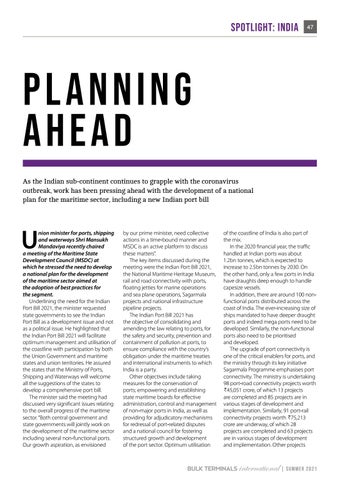SPOTLIGHT: INDIA
47
PL ANNING AHEAD As the Indian sub-continent continues to grapple with the coronavirus outbreak, work has been pressing ahead with the development of a national plan for the maritime sector, including a new Indian port bill
U
nion minister for ports, shipping and waterways Shri Mansukh Mandaviya recently chaired a meeting of the Maritime State Development Council (MSDC) at which he stressed the need to develop a national plan for the development of the maritime sector aimed at the adoption of best practices for the segment. Underlining the need for the Indian Port Bill 2021, the minister requested state governments to see the Indian Port Bill as a development issue and not as a political issue. He highlighted that the Indian Port Bill 2021 will facilitate optimum management and utilisation of the coastline with participation by both the Union Government and maritime states and union territories. He assured the states that the Ministry of Ports, Shipping and Waterways will welcome all the suggestions of the states to develop a comprehensive port bill. The minister said the meeting had discussed very significant issues relating to the overall progress of the maritime sector. “Both central government and state governments will jointly work on the development of the maritime sector including several non-functional ports. Our growth aspiration, as envisioned
by our prime minister, need collective actions in a time-bound manner and MSDC is an active platform to discuss these matters’’. The key items discussed during the meeting were the Indian Port Bill 2021, the National Maritime Heritage Museum, rail and road connectivity with ports, floating jetties for marine operations and sea plane operations, Sagarmala projects and national infrastructure pipeline projects. The Indian Port Bill 2021 has the objective of consolidating and amending the law relating to ports, for the safety and security, prevention and containment of pollution at ports, to ensure compliance with the country’s obligation under the maritime treaties and international instruments to which India is a party. Other objectives include taking measures for the conservation of ports; empowering and establishing state maritime boards for effective administration, control and management of non-major ports in India, as well as providing for adjudicatory mechanisms for redressal of port-related disputes and a national council for fostering structured growth and development of the port sector. Optimum utilisation
of the coastline of India is also part of the mix. In the 2020 financial year, the traffic handled at Indian ports was about 1.2bn tonnes, which is expected to increase to 2.5bn tonnes by 2030. On the other hand, only a few ports in India have draughts deep enough to handle capesize vessels. In addition, there are around 100 nonfunctional ports distributed across the coast of India. The ever-increasing size of ships mandated to have deeper draught ports and indeed mega ports need to be developed. Similarly, the non-functional ports also need to be prioritised and developed. The upgrade of port connectivity is one of the critical enablers for ports, and the ministry through its key initiative Sagarmala Programme emphasises port connectivity. The ministry is undertaking 98 port-road connectivity projects worth ₹45,051 crore, of which 13 projects are completed and 85 projects are in various stages of development and implementation. Similarly, 91 port-rail connectivity projects worth ₹75,213 crore are underway, of which 28 projects are completed and 63 projects are in various stages of development and implementation. Other projects
BULK TERMINALS
international | SUMMER 2021












